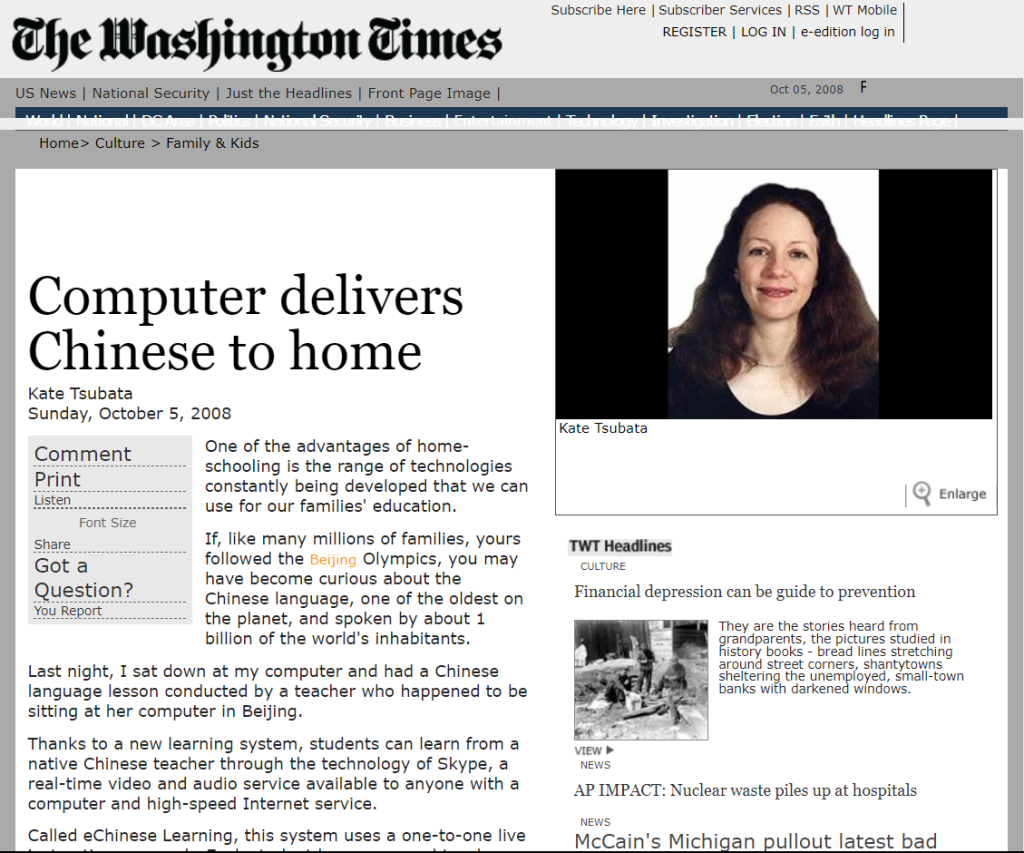Media Coverage
Computer delivers Chinese to home
Oct 05, 2008 Source: The Washington Times

One of the advantages of home-schooling is the range of technologies constantly being developed that we can use for our families’ education.
If, like many millions of families, yours followed the Beijing Olympics, you may have become curious about the Chinese language, one of the oldest on the planet, and spoken by about 1 billion of the world’s inhabitants.
Last night, I sat down at my computer and had a Chinese language lesson conducted by a teacher who happened to be sitting at her computer in Beijing.
Thanks to a new learning system, students can learn from a native Chinese teacher through the technology of Skype, a real-time video and audio service available to anyone with a computer and high-speed Internet service.
Called eChinese Learning, this system uses a one-to-one live instruction approach. Each student has a personal teacher, on camera, conversing directly — even if they are separated by vast geographic distances. The student can hear the teacher’s correct pronunciation, and see what the teacher writes on the board. When the student imitates the sounds, the teacher can correct their pronunciation. The student also can show the teacher his or her own written work on camera, and get immediate response.
I was instructed by an excellent teacher,Hong Zou. Ms. Zou, or Laoshi Zou (Teacher Zou) as I could call her by the end of the session.
Quickly, she had me responding to her greetings in Mandarin. I already knew “Ni hao ma?” — “How are you?” — but within minutes I had learned “Wo hen hao” (“I’m fine”), “Ni ne?” (And you?) as well as “Wo ye hen hao” (“I’m fine, too”). I learned to introduce myself, and how to teach my children to introduce themselves. “Wo Jiao Kate,” was followed by “Wo ai ni,” or “I love you.” I learned the first three numbers, and then the four tones for each Chinese vowel.
The sound for “one” is “i” — pronounced “eee.” However, if you say the sound with a rising intonation, it may sound like “eee?” and mean “aunt.” If the vowel has a V-shaped tone symbol over it, it may sound like “ee ee” and would mean “chair.” Finally, a downward accent would make it sound like an emphatic order: “ee!” and it would mean the number “1 billion.”
In just 30 minutes, I learned the various personal pronouns, singular and plural, and how to express “more and more” (yue lai yue hao). The teacher was very good about creating personalized ways for me to learn, by asking questions about my life and my family.
While hiring a personal native speaking language instructor normally would cost from about $20 to $35 per hour, the eChinese Learning package can provide real-time personal teaching for about half that cost. But it’s not necessary to sign up without experiencing the value: eChinese Learning offers you a free session to “test drive” the instructional experience. I must say that I learned more in 30 minutes than from the textbook and recording-based systems I have used in the past.
In my language-learning experience, this is a very effective and interactive way to effectively develop a strong knowledge of a new language.
To check it out, and to schedule a free introductory lesson, go to www.echineselearning.com. You will need to register for Skype, and you’ll need a webcam or some other camera set up connected to your desktop or laptop, with a microphone function. There are a variety of learning packages, oriented toward adult professionals, teens, young children and even those interested in Olympic-based vocabulary and communication. Feel free to give them a call or send an inquiry – they’re very happy to discuss your learning goals and suggest options.
Jai Jin, Nimen (Goodbye).
Sign up for a free trial now
Get a FREE live 1-to-1 lesson and FREE e-books. Complete the form below:
马上注册免费中文课程!
请填写下列表单,您将免费得到多本学中文的电子书和一节中文体验课。
馬上註冊免費的中文體驗課
請填寫下列表單,您將免費得到多本學中文的電子書和一節中文體驗課。
Sign up for a free trial now
Get a FREE live 1-to-1 lesson and FREE e-books. Complete the form below:
马上注册免费中文课程!
请填写下列表单,您将免费得到多本学中文的电子书和一节中文体验课。
馬上註冊免費的中文體驗課
請填寫下列表單,您將免費得到多本學中文的電子書和一節中文體驗課。




